Why a Waitress Cover Letter Matters
In the competitive world of job hunting, a well-crafted waitress cover letter can be your secret weapon. It’s more than just a formality; it’s your first chance to make a strong impression on a potential employer. A compelling cover letter complements your resume, providing context and personality that a list of skills and experiences alone cannot. It allows you to showcase your enthusiasm, highlight relevant skills, and demonstrate why you’re the perfect fit for the role. By taking the time to create a personalized cover letter, you significantly increase your chances of landing an interview and ultimately, the job. It is a powerful tool to set you apart from other applicants.
Key Components of a Winning Waitress Cover Letter
A winning waitress cover letter is a carefully constructed document that includes several key components. Each section plays a crucial role in conveying your qualifications and making a positive impression. Start by ensuring your contact information is accurate and easy to find. Then, craft a compelling opening paragraph that grabs the reader’s attention. Follow this with sections that highlight your skills and experience, quantifying your achievements whenever possible. Demonstrate your passion for the role and end with a strong closing paragraph that includes a call to action. Let’s explore these essential components in detail to help you create a cover letter that stands out.
Contact Information Section
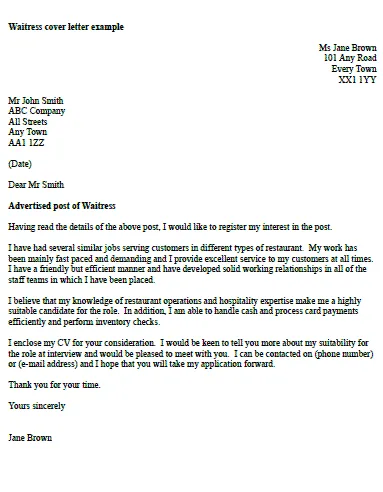
The contact information section is the first element of your cover letter and should be clear, concise, and accurate. Begin by including your full name, address, phone number, and email address. Make sure your email address is professional-sounding; avoid using nicknames or informal language. Double-check all the information to ensure there are no typos. This section allows the employer to easily reach you for an interview or to ask any follow-up questions. Placing this information at the top of your cover letter ensures it’s easily accessible to the hiring manager, saving them time and making it simple for them to reach you, helping to establish a positive first impression.
The Greeting Write a Proper Salutation
A proper greeting sets the tone for your entire cover letter. Whenever possible, address the hiring manager by name. Research the restaurant or company to find out who is in charge of hiring. A personalized greeting, such as “Dear Mr. Smith,” shows that you’ve taken the time to do your research and that you are genuinely interested in the position. If you’re unable to find a specific name, you can use a professional alternative, such as “Dear Hiring Manager,” or “Dear Restaurant Management.” Avoid generic greetings like “To Whom It May Concern,” as these can make your letter seem impersonal. The goal is to establish a connection from the start.
Opening Paragraph Grab Their Attention
The opening paragraph is your first opportunity to make a strong impression. It should immediately capture the reader’s attention and make them want to learn more about you. Start by stating the specific position you’re applying for and how you found the job opening. Then, briefly highlight your key qualifications and why you’re a great fit for the role. Show your enthusiasm for the restaurant and the opportunity to work there. A compelling opening paragraph sets the stage for the rest of your letter. This is the moment to demonstrate your enthusiasm and convince the employer to continue reading. Make sure your opening is clear, concise, and engaging.
Highlighting Relevant Skills and Experience
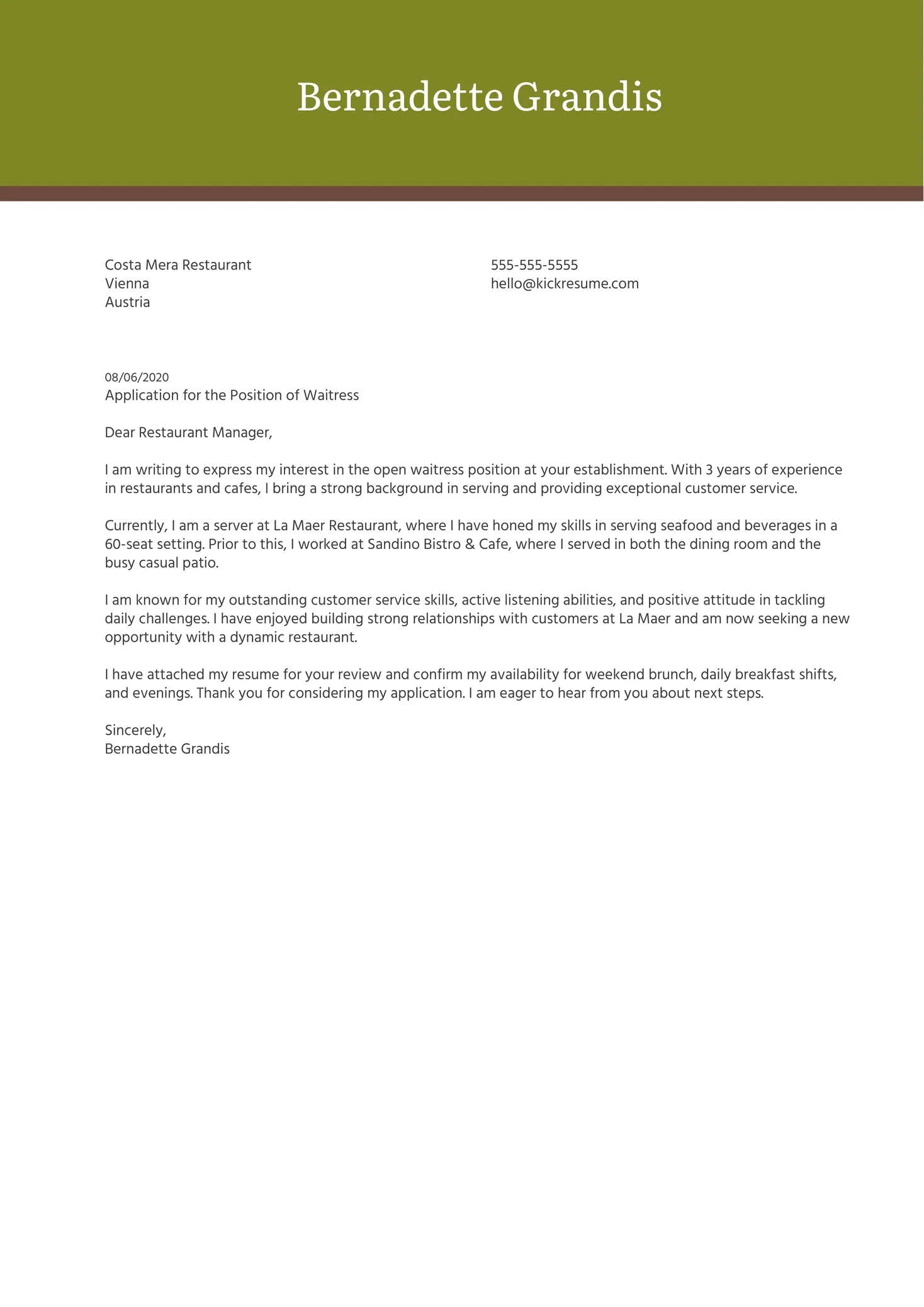
In the body of your cover letter, focus on showcasing your relevant skills and experience. Tailor your skills to the specific requirements of the waitress position. Highlight skills such as excellent customer service, communication, multitasking, and the ability to work well under pressure. Provide specific examples to demonstrate how you’ve used these skills in previous roles. Quantify your accomplishments whenever possible. For instance, instead of saying “Managed a busy section,” say “Managed a section of 15 tables, ensuring efficient service and high customer satisfaction.” The ability to demonstrate your skills with concrete examples will significantly increase your credibility.
Showcasing Customer Service Abilities
Customer service is at the heart of the waitress role, so it’s essential to highlight your customer service abilities. Describe your approach to handling customer requests, resolving complaints, and ensuring a positive dining experience. Mention specific examples of how you’ve gone above and beyond to satisfy customers. Demonstrate your ability to remain calm and professional, even in challenging situations. Providing examples of how you’ve handled difficult customers or successfully resolved a complaint will impress the hiring manager. Customer service is key, so make sure this section reflects your strengths in this area.
Mentioning Previous Restaurant Experience
If you have previous experience working in a restaurant, be sure to highlight it in your cover letter. Describe your previous roles, responsibilities, and the skills you gained. Mention the names of the restaurants and the duration of your employment. If you have any specific achievements, such as receiving positive customer feedback or being recognized for outstanding service, include them. Even if your experience is limited, emphasize any transferable skills, such as teamwork, time management, or cash handling. Focus on the positive aspects of your prior experience, and explain how your skills align with the requirements of the waitress position.
Quantifying Achievements and Results
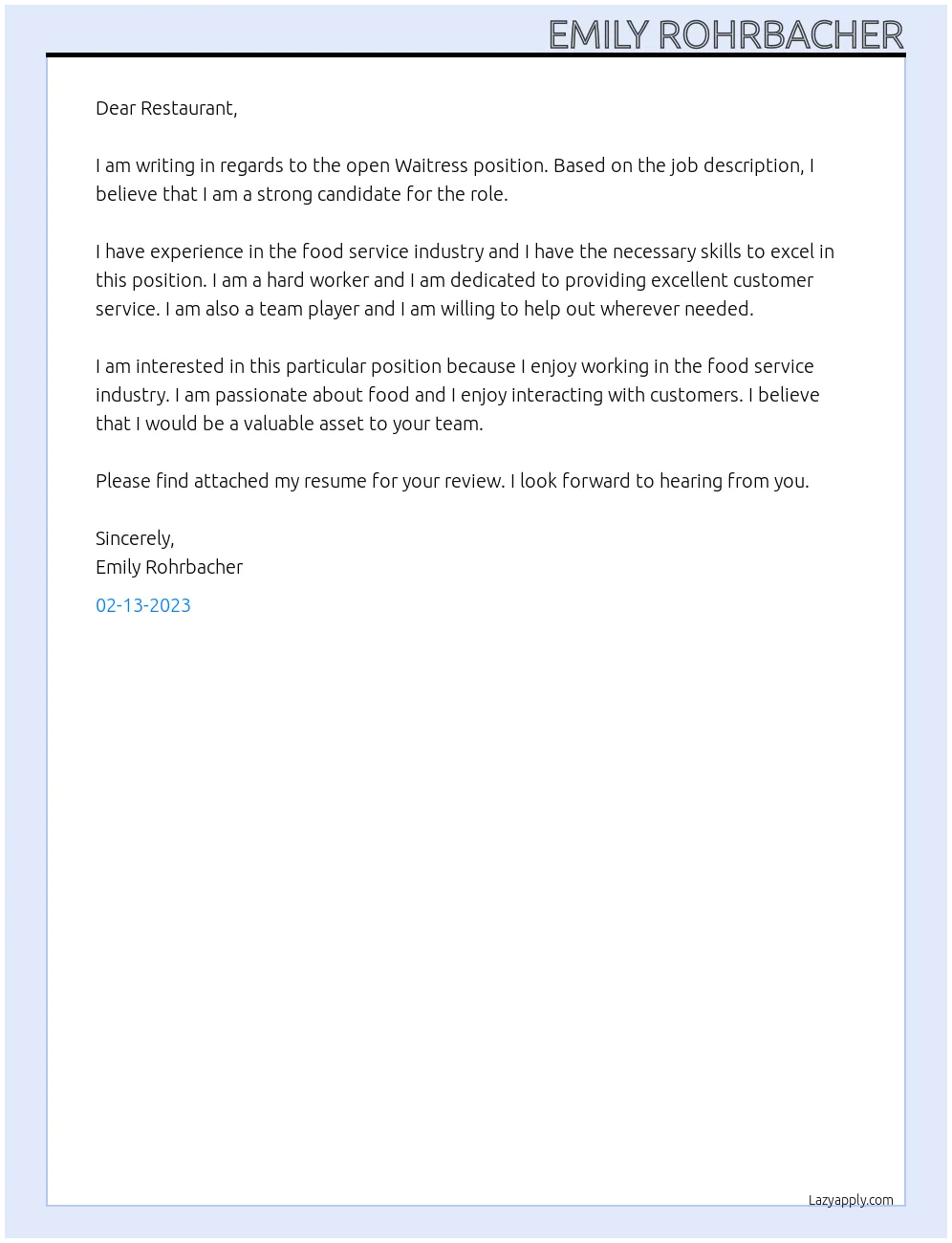
Quantifying your achievements and results makes your cover letter more impactful. Instead of simply stating that you provided good service, provide concrete examples and data to support your claims. For example, you could mention the number of tables you served per shift, the average tip percentage you received, or any positive feedback you received from customers. Whenever possible, use numbers and statistics to illustrate your successes. This helps the hiring manager to understand the value you bring to a team. Quantifiable achievements are far more persuasive than general statements of your skills or abilities. Use this opportunity to prove your value.
Demonstrating Passion for the Role
Demonstrate your passion for the waitress role and your interest in working at the specific restaurant. Explain why you’re drawn to the hospitality industry and what motivates you to provide exceptional customer service. Research the restaurant and mention something specific that attracts you to their brand or menu. Showing genuine enthusiasm will leave a lasting impression on the hiring manager. A clear demonstration of your enthusiasm can differentiate you from other applicants. This level of detail shows the employer that you have taken the time to research and understand their business, and that you are genuinely interested in joining their team.
Closing Paragraph and Call to Action
The closing paragraph should summarize your interest in the position and reiterate your qualifications. Express your enthusiasm for the opportunity and thank the hiring manager for their time and consideration. This is also the place to include a clear call to action. For example, state that you are available for an interview at their earliest convenience. Provide your contact information again or state that you look forward to hearing from them soon. A strong closing paragraph ensures the reader remembers you and encourages them to take the next step.
Expressing Gratitude and Following Up

Expressing your gratitude for the opportunity and offering to follow up is a crucial part of the closing. Thank the hiring manager for considering your application and their time. State that you are looking forward to the next step in the hiring process. If you are inclined, you can mention that you will follow up within a week or two to reiterate your interest in the position. This shows initiative and persistence. A simple “Thank you for your time and consideration. I look forward to hearing from you soon” is sufficient. Doing so ensures the reader feels appreciated and it adds to your overall professionalism. A follow-up email a week or two later also keeps you at the forefront.
Essential Tips for Writing Your Cover Letter
To create a compelling waitress cover letter, keep these essential tips in mind. Use a professional and readable font, such as Arial or Times New Roman. Keep your letter concise and focused; aim for one page. Proofread your letter carefully for any grammatical errors or typos. Tailor your cover letter to each job application; don’t use a generic template. Highlight the skills and experience most relevant to the specific position and restaurant. By following these tips, you can ensure your cover letter is professional, engaging, and tailored to each application, increasing your chances of securing an interview.
Tailoring Your Letter to the Specific Job
Tailoring your cover letter to each job application is a crucial step in making a positive impression. Before writing, carefully review the job description and identify the key requirements and desired skills. Research the restaurant and understand its values, mission, and the type of experience it offers. Then, customize your cover letter to align with the specific needs of the employer. Highlight the skills and experiences that match the requirements outlined in the job description. Show how your experience aligns with their business needs. By demonstrating your awareness and understanding of the employer’s needs, you will significantly increase the effectiveness of your cover letter.
Proofreading and Formatting Your Letter
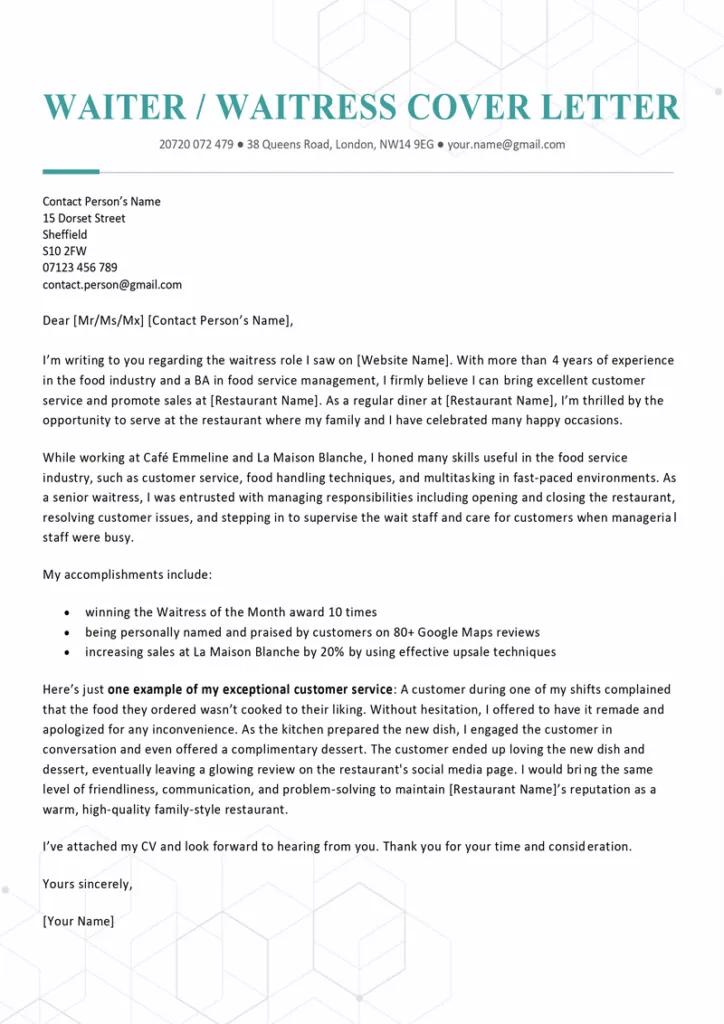
Proofreading and proper formatting are essential aspects of creating a professional cover letter. Before submitting your application, carefully proofread your letter for any grammatical errors, typos, or inconsistencies. Check the spelling of the hiring manager’s name and restaurant name. Use a clean and easy-to-read font and maintain consistent formatting throughout your letter. Make sure your contact information is accurate and up-to-date. Reading your letter aloud can often help you catch mistakes that you might miss when reading silently. Consider having a friend or family member review your letter as a second pair of eyes can help you identify areas for improvement.
Common Mistakes to Avoid
Avoiding common mistakes can significantly improve the quality of your cover letter. Here are some common pitfalls to avoid to maximize your chances of success. Ensure your cover letter is focused and targeted for each application. Steer clear of these common errors to present yourself as the best candidate.
Using Generic Language
One common mistake is using generic, uninspired language that could apply to any job. Avoid using clichés or generic phrases, as these can make your cover letter seem impersonal and unoriginal. Instead, use specific examples and tailor your language to the specific role and restaurant. Demonstrate your understanding of the job’s requirements and highlight the relevant skills and experience. Generic language does not demonstrate your interest or tailor your application.
Focusing Solely on Yourself
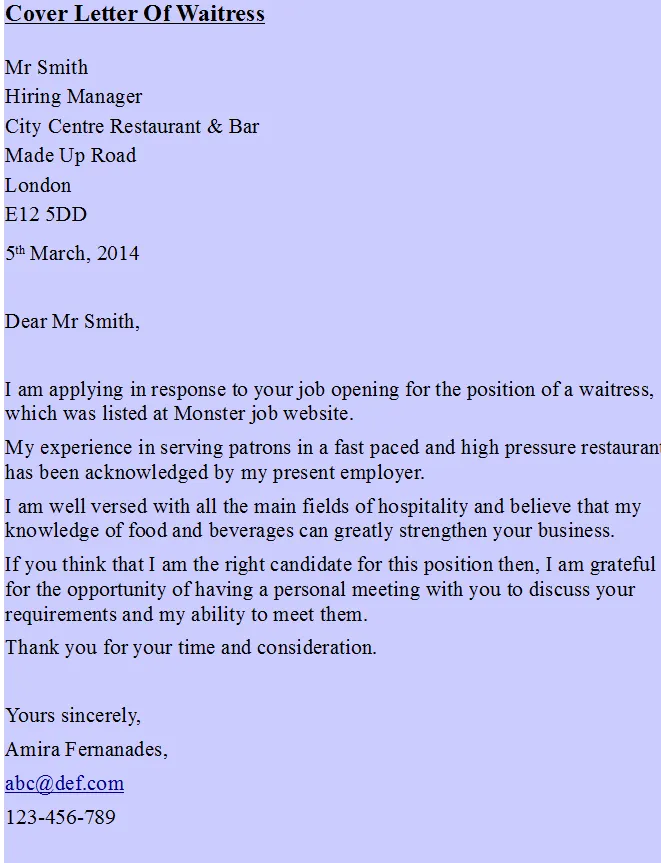
While your cover letter should highlight your skills and experience, avoid focusing solely on yourself. Instead, focus on how your skills and experience align with the employer’s needs and what value you can bring to the role. Demonstrate how you can contribute to the restaurant’s success and provide exceptional customer service. Show them that you understand what they’re looking for in a candidate. Employers are interested in what you can do for them, so always address this in your cover letter.
Ignoring the Employer’s Needs
Failing to address the employer’s needs is a critical mistake. Research the restaurant and understand its values, mission, and the type of experience it offers. Tailor your cover letter to align with these aspects and show how you can contribute to the restaurant’s success. Highlight the skills and experiences that match the requirements outlined in the job description. Demonstrate your awareness and understanding of the employer’s needs, and explain how your skills will benefit their establishment. Always demonstrate that you have understood the employer’s needs.
Cover Letter Examples for Waitresses
Reviewing cover letter examples for waitresses can help you understand the best practices and gain inspiration for your own application. Look for examples that highlight relevant skills, such as customer service, communication, and multitasking. Pay attention to the tone and language used, and how the applicant showcases their experience and enthusiasm. Use these examples as a starting point to create a cover letter that reflects your personality and qualifications. Adapt the examples to fit your own experiences.
Entry-Level Waitress Cover Letter
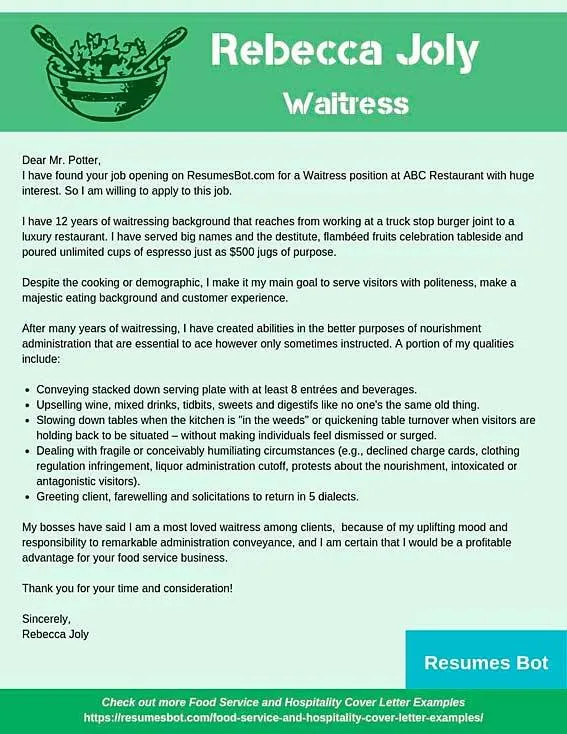
If you’re applying for an entry-level waitress position, focus on highlighting any customer service experience, even if it’s from a non-restaurant job. Showcase your enthusiasm for the role and your willingness to learn. Mention any relevant skills, such as communication, teamwork, and the ability to handle pressure. Tailor your cover letter to the specific job, emphasizing any specific skills or qualities the employer is seeking. If you lack direct experience, emphasize any transferable skills. Highlight how you have demonstrated the abilities the role requires through previous experiences, even outside of restaurant work.
Experienced Waitress Cover Letter
For experienced waitresses, your cover letter should emphasize your achievements and quantify your results. Mention previous roles, responsibilities, and any notable accomplishments. Provide specific examples of how you’ve improved customer satisfaction, increased sales, or streamlined processes. Showcase your ability to handle high-pressure situations, resolve customer complaints, and work efficiently in a team. Highlight skills such as experience with point-of-sale systems, order accuracy, and menu knowledge. Provide quantifiable results whenever possible, such as average tip percentages, number of tables served, or any awards or recognition received. These figures support your experience.
